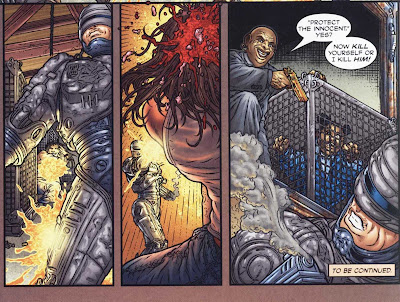Frank Miller's Robocop
Steven Grant (script) and Juan Jose Ryp (art)
Avatar, 2003 - 2006
trade paperback compilation, Boom! Studios, August 2013
The Robocop franchise has bounced around several comic book publishers since the original movie first was released in July, 1987. Marvel was the initial franchisee during 1987 - 1990, followed by Dark Horse from 1992 - 1994, and then Avatar from 2003 - 2006.
In 2010 Dynamite took a turn, and more recently, Boom! Studios has been the publisher.
The best of all these Robocop comic book series are Dark Horse's Robocop Vs The Terminator (1992), and Avatar's Frank Miller's Robocop (2003 - 2006).
Acquiring the individual books in Frank Miller's Robocop is rather expensive, particularly when you take into account the existence of numerous cover variants, which the fanboys have held onto in the hopes of receiving exorbitant resell prices. Probably the best way to acquire the series is to pick up the trade paperback compilation, titled Frank Miller's Robocop Volume 1, that Boom! released in 2013.
The story goes that Frank Miller's initial script for the film was deemed 'unfilmable' (whatever that means), and the script used in the actual filming had been subjected to considerable re-writing. Accordingly, Frank Miller's Robocop relies on the 'original' script and deviates in many aspects from the film.
I won't disclose any spoilers, save to say that it does share with the film the epic confrontation between Robocop and the super-powerful 'Robocop 2' cyborg, within which is implanted the brain of an amoral, homicidal personality.
I thought Robocop 2 was a great film, with plenty of black humor well-served by the over-the-top violence. Does Frank Miller's Robocop do a good job in its particular version of the story ? The short answer is yes, it does.
First and foremost, this comic series is all about the work of Spanish-born artist Juan Jose Ryp, one of the most talented artists working in comic books nowadays.
With all nine issues of Frank Miller's Robocop, Ryp's unique draftsmanship is on full display, aided and abetted by an impressive coloring job from Nimbus Studios.
To call Ryp's pencil work 'meticulous' and 'detailed' is an understatement.....it often takes me several minutes to completely take in the contents of a single panel, much less an entire page........!
When Ryp draws a gunshot wound - as he does in the center panel above - he doesn't just draw a gout of blood. He draws little fragments of skull bone and shreds of tissue travelling outward from the exit wound - !
Curs snarling at each other in the street have patches of mange on their fur. Little puffs of smoke accompany the friction of a police car's tires scraping the asphalt.
Explosions and fireballs are carefully rendered to show individual plumes and contrails of flame, accompanied by fragments of atomized limb...
Ryp provides plenty of Easter Eggs and in-jokes for the discerning reader. For example, look carefully at the bottom portion of the back cover to issue 6.....
Do you see Homer ?
Note the detail of the warping and pitting and discoloration of the rebar just to upper left of Homer's head. It must have taken Ryp an entire day - if not longer - to draw just this bottom portion of the back cover of this one issue. Insane !
The 'sequential adaptation' (as opposed to writing or scripting) by Steven Grant does the right thing in adopting a 'European' style, minimizing sound effects and limiting the superposition of text to spoken-word balloons. There are no narrative boxes or thought balloons. There is little in the way of distraction from Ryp's artwork.
Avatar is one publisher that is very conscious of printing its comics with high production values, and the issues of Frank Miller's Robocop benefit from this approach, as the books use a glossy, high-quality paper stock with very good color reproductions.
The comic book series has its share of laugh-out-loud, satirical humor. One of my favorite sequences is this one involving 'Johnny Rehab':
Summing up: whether you're a Robocop fan, or simply someone who appreciates great graphic art, getting a copy of Frank Miller's Robocop is a very worthwhile investment. It'll be a long time before anyone tops this deliverable from the franchise.......
























































.jpg)





















